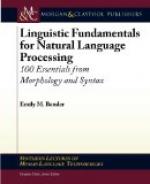A complex idea is a combination of several simple ones, as a tree is made up of roots, a trunk, branches, twigs, and leaves. And these again may be divided into the wood, the bark, the sap, &c. Or we may employ the botanical terms, and enumerate its external and internal parts and qualities; the whole anatomy and physiology, as well as variety and history of trees of that species, and show its characteristic distinctions; for the mind receives a different impression on looking at a maple, a birch, a poplar, a tamarisk, a sycamore, or hemlock. In this way complex ideas are formed, distinct in their parts, but blended in a common whole; and, in conformity with the law regulating language, words, sounds or signs, are employed to express the complex whole, or each distinctive part. The same may be said of all things of like character. But this idea I will illustrate more at large before the close of this lecture.
First impressions are produced by a view of material things, as we have already seen; and the notion of action is obtained from a knowledge of the changes these things undergo. The idea of quality and definition is produced by contrast and comparison. Children soon learn the difference between a sweet apple and a sour one, a white rose and a red one, a hard seat and a soft one, harmonious sounds and those that are discordant, a pleasant smell and one that is disagreeable. As the mind advances, the application is varied, and they speak of a sweet rose, changing from taste and sight to smell, of a sweet song, of a hard apple, &c. According to the qualities thus learned, you may talk to them intelligibly of the sweetness of an apple, the color of a rose, the hardness of iron, the harmony of sounds, the smell or scent of things which possess that quality. As these agree or disagree with their comfort, they will call them good or bad, and speak of the qualities of goodness and badness, as if possessed by the thing itself.
In this apparently indiscriminate use of words, the ideas remain distinct; and each sign or object calls them up separately and associates them together, till, at length, in the single object is associated all the ideas entertained of its size, qualities, relations, and affinities.
In this manner, after long, persevering toil, principles of thought are fixed, and a foundation laid for the whole course of future thinking and speaking. The ideas become less simple and distinct. Just as fast as the mind advances in the knowledge of things, language keeps pace with the ideas, and even goes beyond them, so that in process of time a single term will not unfrequently represent a complexity of ideas, one of which will signify a whole combination of things.




